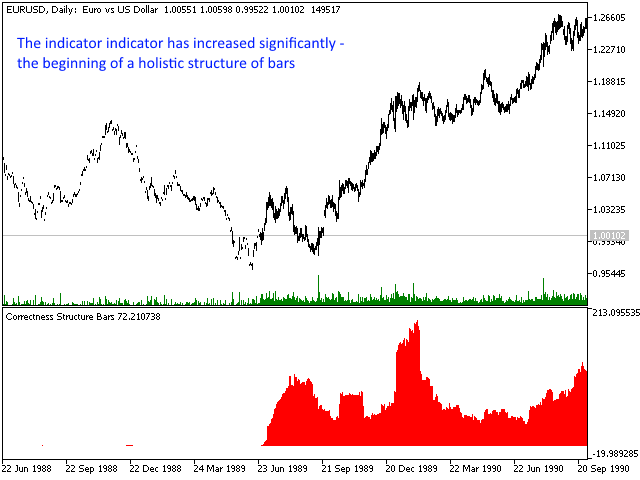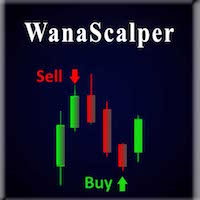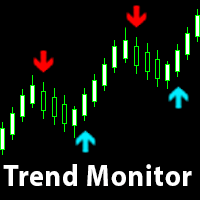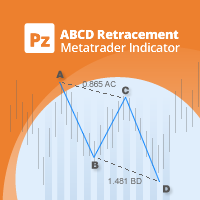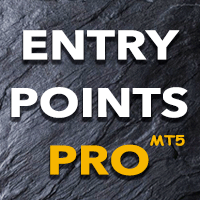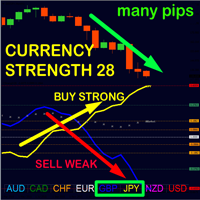Correctness Structure Bars
- Indicateurs
- Yvan Musatov
- Version: 1.0
- Activations: 5
The Correctness Structure Bars indicator displays the bar structure in digital terms. How to Interpret the Information Provided by the Indicator It is very simple, all you have to do is analyze the chart. We will explain the work using an example, take the EURUSD instrument on the D1 timeframe, install this indicator and analyze the information provided by the indicator. The indicator works in the bottom of the chart and gives the result in the form of a histogram, that is, each bar (when a bar appears on the zero bar) forms a digital value, a histogram column, by which we can analyze the correctness of the price chart presented on the chart. Let's start the analysis with an example.
Consider picture #1. This is the beginning of the story for the EURUSD currency pair on the D1 timeframe. Here we see that the digital values that the indicator gives in the form of a histogram at the beginning of the chart are zero, and in the second part of the chart it is greater than zero but less than two. At the same time, on the price chart, we see (especially if you zoom in on the chart on your chart) poorly formed bars without a clear structure of the open price, close price and shadows. Looking ahead, we can interpret these indicators as reflecting poorly formed bar bodies in the form of a low resulting value of this indicator. And with automated trading on such a history, it is better not to work at all, or switch to some other specific game strategy.
Consider picture #2. This screenshot immediately follows the previous one in history. Here you can see that the indicator indicator is changing, but still it is not more than two, at the same time the structure of the bars is not complete, as in the previous case.
Consider picture #3. To do this, you need to scroll forward through history, because by now we will see a picture similar to the previous one (No. 1 and No. 2). In this screenshot, we can see that in 1989 the indicators of the indicator changed dramatically and became significantly higher than two, in some places the indicators were more than 200. We also clearly see on the price chart that the structure of the bars has changed (if you zoom in, you can see it more clearly). Now, where the structure of the bars is more clearly expressed and correctly formed, there is a body of bars and a shadow, and the indicators of the indicator have also increased significantly. In this case, for automated systems, this will be a clear signal to change the trading strategy, or most often just start trading, and the entire history up to the present moment can simply be ignored due to its structural integrity.
Consider picture number 4. To do this, you need to scroll forward through history, because by now we will see a picture similar to the previous one (No. 3). In this screenshot, we can see a clear anomaly where the indicator rises to almost 700 values, at the same time we see that the market was making very large unpredictable movements in 2008 on EURUSD. The indicator displays the structural integrity of the bars as well as indirect predictability, from this we can conclude that the more integral the structure of the bars, the worse the predictability and therefore it is better to trade in the range of the normal structure of the bars and avoid abnormal zones. The indicator can be interpreted as a forecast indicator and used as a filter. The lower the indicator reading, the more predictable the price movement and the worse the structure of the bars. The higher the indicator reading, the more pronounced the structure of the bars, but the price dynamics is difficult to predict. In this case, you can introduce a trading rule under which, if the indicator readings are higher, for example, 200, price movements are difficult to predict and it is better to refrain from trading.
Consider picture number 5. The usual price movement on the price chart, the usual trading system will work, no filters or trade prohibitions are required, the market is structured and predictable.
The length indicator parameter is the number of the last bars to be analyzed (except for the zero bar). That is, the analysis of the last (length) formed bars is displayed on the zero bar. This approach allows the indicator to provide clear indicators that do not change on the zero bar.



